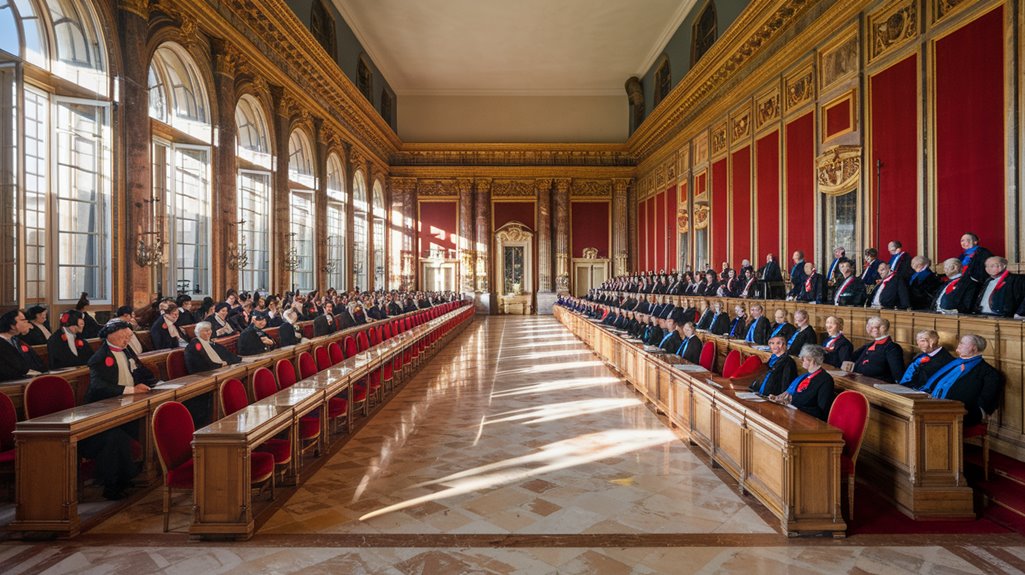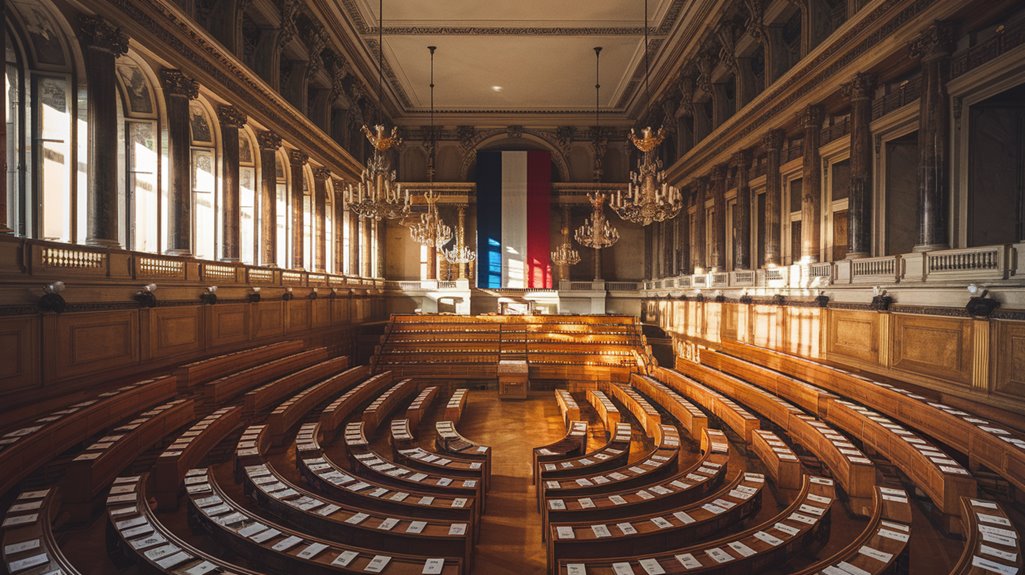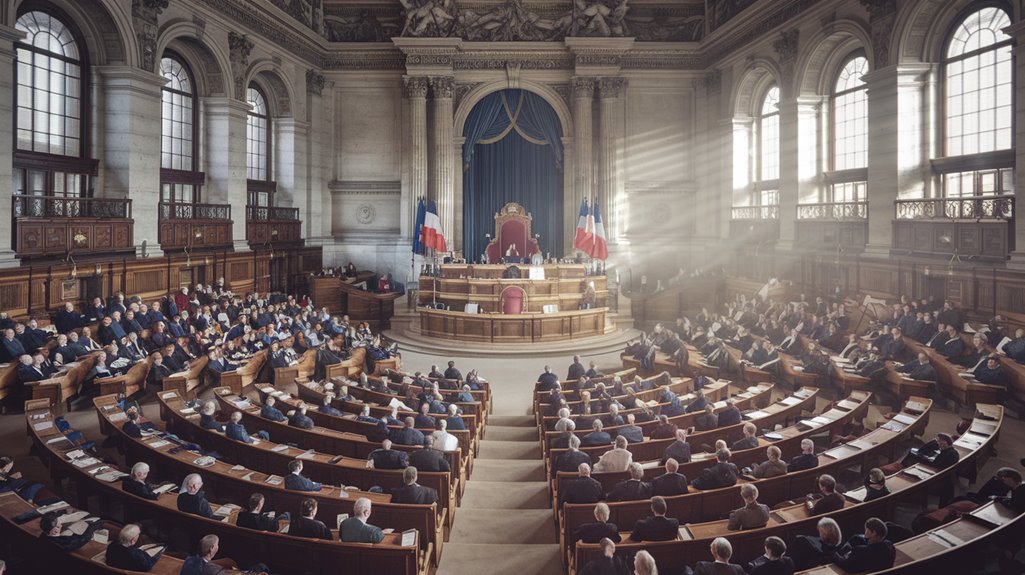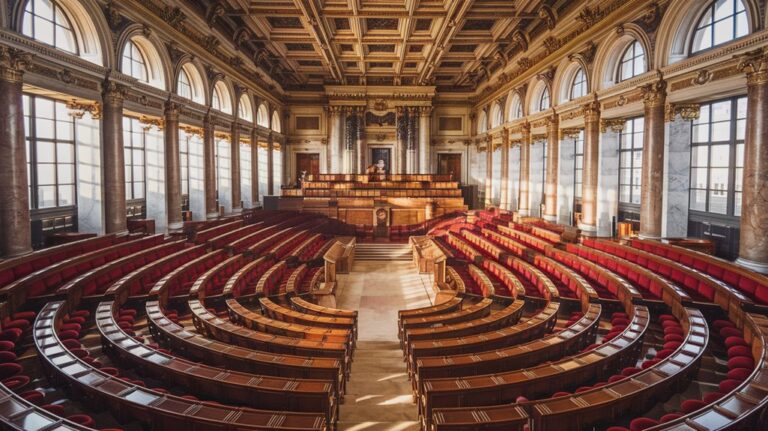Where ‘Left’ vs. ‘Right’ in Politics Began
When you're choosing a seat in a classroom, your position might reveal more than just your preferred view of the chalkboard. In a similar way, the birth of our modern political labels came from a simple seating arrangement. During the French Revolution's National Assembly of 1789, legislators made choices that would echo through centuries—monarchists instinctively clustered to the right, while revolutionaries gathered on the left. You'll find that this seemingly simple seating chart launched a political shorthand that shapes global politics to this day.
The French Revolution's Seating Legacy

While many aspects of modern politics seem complex, the simple seating arrangement in France's National Assembly of 1789 gave us the enduring political terms "left" and "right."
During heated debates over the king's power, supporters of the monarchy sat on the right side of the chamber, while those favoring revolutionary change positioned themselves on the left.
The seating significance extended beyond mere positioning, as it established a lasting framework for political identification.
This revolutionary symbolism continued through subsequent French legislatures, including the Legislative Assembly and National Convention.
These terms quickly found their way into popular newspaper reporting as the revolution unfolded.
You'll find that these terms spread globally, shaping political discourse across nations. After 1848, these political labels evolved as they began to represent specific political ideologies rather than just physical positions in the legislature.
Even after the Thermidorian Reaction abolished the original seating method in 1794, the left-right political spectrum had already taken root, influencing how you understand political ideologies today.
Evolution From Physical Space to Political Identity
After spreading beyond the French Assembly, the terms "left" and "right" gradually transformed from mere physical positions into powerful markers of political identity.
Throughout Europe, these terms evolved into a rich political symbolism that shaped ideological discourse for over 75 years into the early 20th century. Today, consistent conservatives and liberals display strikingly different media habits when consuming news and information.
You'll find that historical interpretations of these terms varied greatly across different contexts. In Bolshevik Russia, they were used to identify deviations from Communist party ideology, while across Europe, they helped define the complex politics of nation and class. Today, the ideological center has shrunk as more Americans adopt consistently liberal or conservative positions.
During the interwar years, these terms became increasingly polarized as citizens wrestled with competing political visions. What started as simple seating arrangements had become a versatile political language, replacing older terms like "reds" and "the reaction" to describe citizens' political beliefs.
Core Principles That Defined Each Side
These political labels took on distinct ideological meanings through core principles that still influence modern politics.
The left advocated for economic intervention, social reform, and greater government regulation to address inequalities. They believed in wealth redistribution and using government power to benefit the collective good.
The right championed individual freedom, traditional values, and personal responsibility. They supported free markets with minimal interference and opposed policies that might restrict business growth or personal liberties. The current Republican Party strongly maintains these positions as the main right-wing party in America.
This fundamental division traces back to the French Revolution of 1789, when members of the assembly first physically separated based on their political beliefs.
Key differences emerged in three main areas:
- Economic approach: government management vs. free market solutions
- Social policy: progressive reform vs. traditional stability
- Government role: active involvement vs. limited intervention
These fundamental distinctions continue to shape political discourse and policy debates in modern democracies.
Global Adoption of the Political Spectrum
Since its birth during the French Revolution, the left-right political spectrum has evolved into a global framework for understanding political ideologies.
You'll find its influence has spread from France to nations worldwide, becoming particularly prominent in Western countries during the late 19th and early 20th centuries. During the French Revolution, left supported change while monarchy defenders sat on the right.
This ideological classification system varies across regions. In Western Europe, it centers on class divisions and economic policies, while Eastern European countries often blend nationalist and internationalist positions. Modern analysis like DW-NOMINATE scores helps track legislative voting patterns along this spectrum.
Global political trends show that new democracies tend to adopt this system, though with local adaptations. Research spanning 14 countries across five continents confirms the spectrum's widespread use, despite critics arguing it oversimplifies complex political positions.
Cultural factors, like associating "right" with stability and "left" with change, have helped cement this framework's endurance in political discourse.
Shaping Modern Political Discourse

Modern political discourse has undergone a dramatic transformation through the interplay of traditional and digital media platforms.
You'll notice how media influence has shifted from one-way communication to dynamic interactions between politicians and the public, reshaping political narratives in unprecedented ways. The rise of citizen journalism has empowered previously marginalized voices to participate actively in political discussions.
Social media platforms have become central battlegrounds for political debate, enabling real-time discussions and direct engagement with politicians. Over time, there has been a clear shift toward national media coverage at the expense of local news reporting.
National-level political conversations now use more abstract and moralized language, contributing to increased partisan tensions.
Digital algorithms target specific audiences, creating fragmented public opinion and unstable political coalitions.
You're witnessing a hybrid media system where traditional outlets and social platforms combine to shape political discourse, though this often leads to more polarized and emotionally charged debates.
 two-axis model provides a more comprehensive view of political ideologies by considering both economic and social dimensions.
two-axis model provides a more comprehensive view of political ideologies by considering both economic and social dimensions.
Today's political polarization has made the traditional left-right spectrum more challenging to navigate.
The core distinction between left and right often centers on power distribution preferences, with the left typically favoring de-concentration of power and the right supporting its concentration.
You'll notice that many modern movements, like green politics and populism, display ideological flexibility that defies simple categorization.
Education, age, and media exposure greatly influence how you understand these distinctions.
While newer models like the Political Compass offer more nuanced approaches by considering both economic and authoritarian dimensions, the left-right framework continues to shape political discourse worldwide, evolving to accommodate emerging social and economic issues.










